Flying boats are a rare breed of aircraft these days. Yet while their popularity as versatile flying machines may have faded since their heyday in the 1930s and 1940s, there remain a few that are still going strong, in most cases many decades after they first took to the air.
One such example is a UK-based Catalina flying boat that carries the registration G-PBYA. 3,305 Catalinas were built during the Second World War, but this particular aircraft, which reached its 80th birthday in October 2023, is one of only ten that remain airworthy.
Holding the honorary position as the sole remaining Catalina flying boat left in Europe, in 2024 G-PBYA (also known as ‘Miss Pick Up’ – see below) is marking 20 years on the European air show circuit. Displaying at over 20 events across Europe between May and October 2024, the plane still draws the public’s attention wherever it appears – indeed, the plane even has its own fan club, The Catalina Society, with around 700 members worldwide.
AeroTime looks at the fascinating story behind this particular Catalina – from warbird to water bomber, and from sitting abandoned in Canada to becoming a perennial favorite on the European air show scene.
Background to the PBY Catalina
The PBY Catalina series of flying boats was originally conceived in the 1930s to meet an emerging US Navy requirement for a patrol-bomber flying boat. The San Diego-based aircraft manufacturer Consolidated, which had previous experience producing earlier flying boat models, presented a new design for consideration by the Navy’s top brass.
The design, originally known as the Consolidated Model 28, featured a hull-shaped lower fuselage, with its twin piston engines mounted on the leading edge of the high wing above. The provision of stabilizer floats at the ends of each wing, which could be retracted for streamlined flight, added to the design’s efficiency.
First flown on March 21, 1935, the new aircraft commenced service trials with the US Navy, leading to numerous design adjustments before the Navy ordered 60 examples in June 1935. The first of these, known as the PBY-1, was delivered to them in October 1936. The ‘PB’ stood for ‘patrol bomber’ while ‘Y’ was the designated letter to denote Consolidated as the manufacturer.
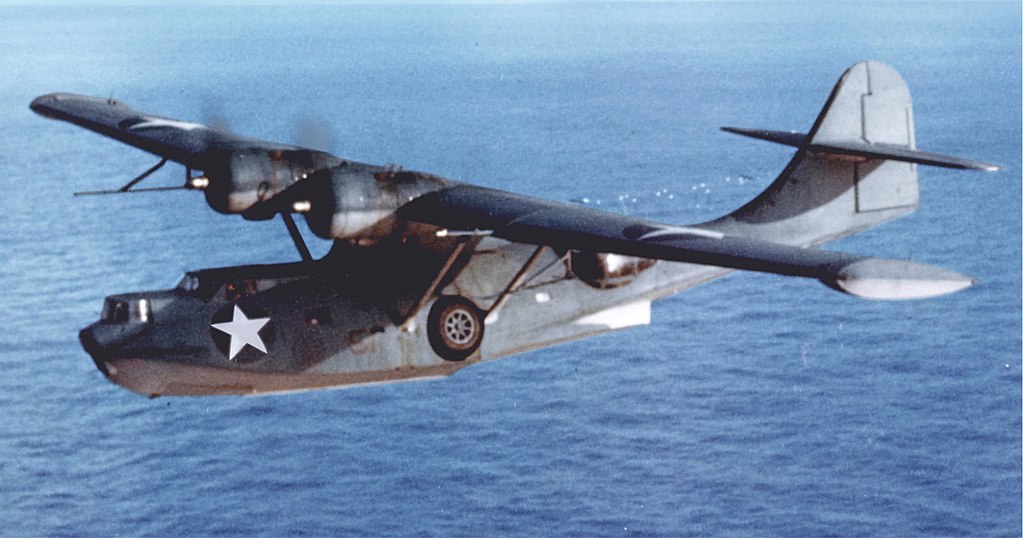
By April 1939, the model had been upgraded several times. The US Navy continued to order increasing numbers of aircraft, including 50 PBY-2s and 66 PBY-3s. The last of 33 PBY-4 variants to be rolled out was fitted with amphibious landing gear for the first time, to increase the type’s versatility and enable it to operate from land-based runways.
This new amphibious model eventually became known as the PBY-5A. However, while the PBY flying boats served the US Navy well, not least by seeing action at Pearl Harbor, they were eventually earmarked for retirement as the war in the Pacific turned in the US’s favor and replacements for the type (such as the Gruman Albatross) became available.
The PBY-5 proved to be particularly popular with military operators outside the US (although the US Navy did eventually order 200). Its adaptability, plus its renowned ability to operate very long-range missions and 18+ hour missions without refueling, were huge selling points for the Catalina.
Following evaluation, the UK’s Air Ministry initially ordered 50 PBY-5s, which helped to revitalize production at Consolidated. It was with this order of PBY-5s, destined for the Royal Air Force (RAF), that the aircraft was given the nickname ‘Catalina’ for the first time, named after an island off the coast of California close to San Diego and a name that even the US military went on to adopt officially.
Other air forces worldwide also placed orders for Catalinas, with the Royal Canadian Air Force (RCAF), Royal New Zealand Air Force, Netherlands Navy, and the Royal Australian Air Force leading the charge.
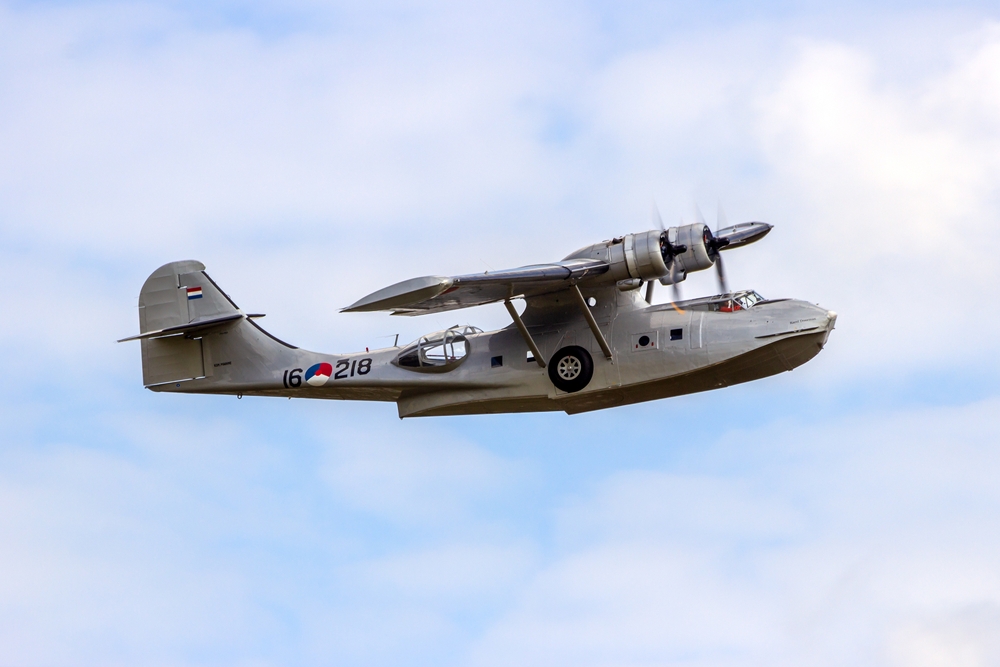
The RCAF order necessitated the opening of a second production line, operated under license by Canadian Vickers at its assembly plant in Cartierville, Quebec. Notably, Catalinas produced by Canadian Vickers were given the alternative moniker of ‘Canso’ rather than Catalina. Boeing Aircraft of Canada Limited also built Catalinas at its plant in Vancouver under license from Consolidated for the US Navy, the RAF, and the RCAF.
In all, 379 aircraft were built in Canada out of the 3,305 Catalinas built in total in the US, Canada, and even the Soviet Union. Of this total production run, 1,428 were built as amphibious examples with fully extendible/retractable landing gear, whereas the remaining 1,877 remained water-borne (although they could be towed onto land via dollies for maintenance and repair).
In the main, the type carried on its role of maritime patrol, characterized by long, monotonous sorties without sighting land or enemy, although others were used as patrol bombers (primarily to destroy enemy submarines), reconnaissance and surveillance, coast guard duties, general cargo transport, and troop relocation missions.
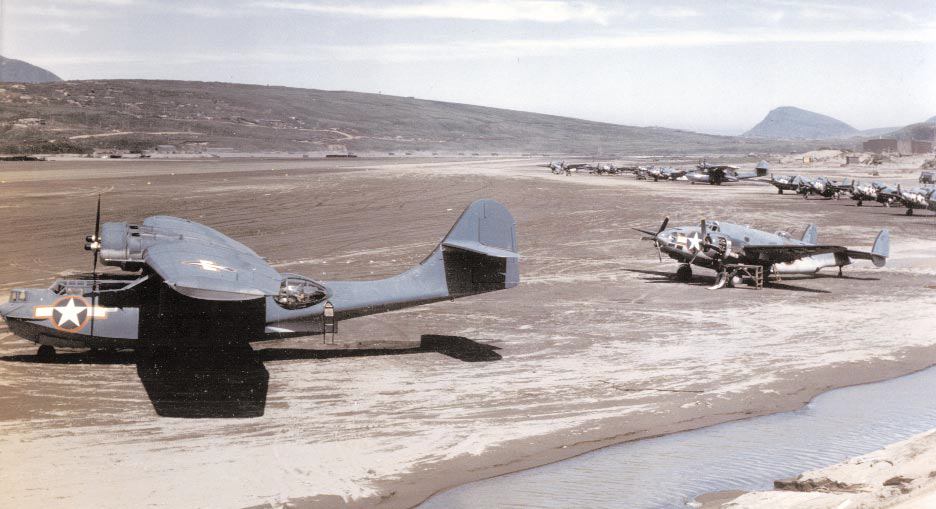
The Catalina served with distinction throughout the Second World War and was involved in many significant incidents, including the locating of the German battleship ‘Bismark’, the sighting of the Japanese invasion force heading for Ceylon (now Sri Lanka), and many individual actions against U-boats and submarines. Two Victoria Crosses were awarded to RAF Coastal Command Catalina captains. In all, the RAF went on to operate around 700 Catalinas.
The vast majority of Catalinas were scrapped after the war. However, a number found new lives in the commercial sector, mostly the amphibious examples, although many of them would never operate on water again. Their new roles varied from passenger and freight transport (Catalinas flew for both Qantas and Cathay Pacific in the post-war years), while others went into specialized roles such as aerial survey, firefighting, or aerial spraying.
Out of the 3,305 Catalinas built in total, it is quite remarkable that only ten remain airworthy across the globe, although there are various restoration projects in various stages worldwide. Most of the surviving examples reside in the US, Canada, and a pair in Australia. G-PBYA remains the sole survivor in Europe, and what a history this aircraft has had over its 80 years of flying.
The history of G-PBYA
G-PBYA was originally ordered for the Royal Canadian Air Force (RCAF) as a ‘Canso A’ amphibious Catalina, based on the US Navy PBY-5A variant. The plane was built by Canadian Vickers at Cartierville, Quebec in October 1943, and was allocated the construction number CV-283 before adopting the RCAF serial 11005 (fuselage markings QT005). The aircraft entered service on October 27, 1943, initially from Bella Bella on the British Columbia coast between Vancouver and Prince Rupert, on day and night patrols to keep watch for enemy submarines.
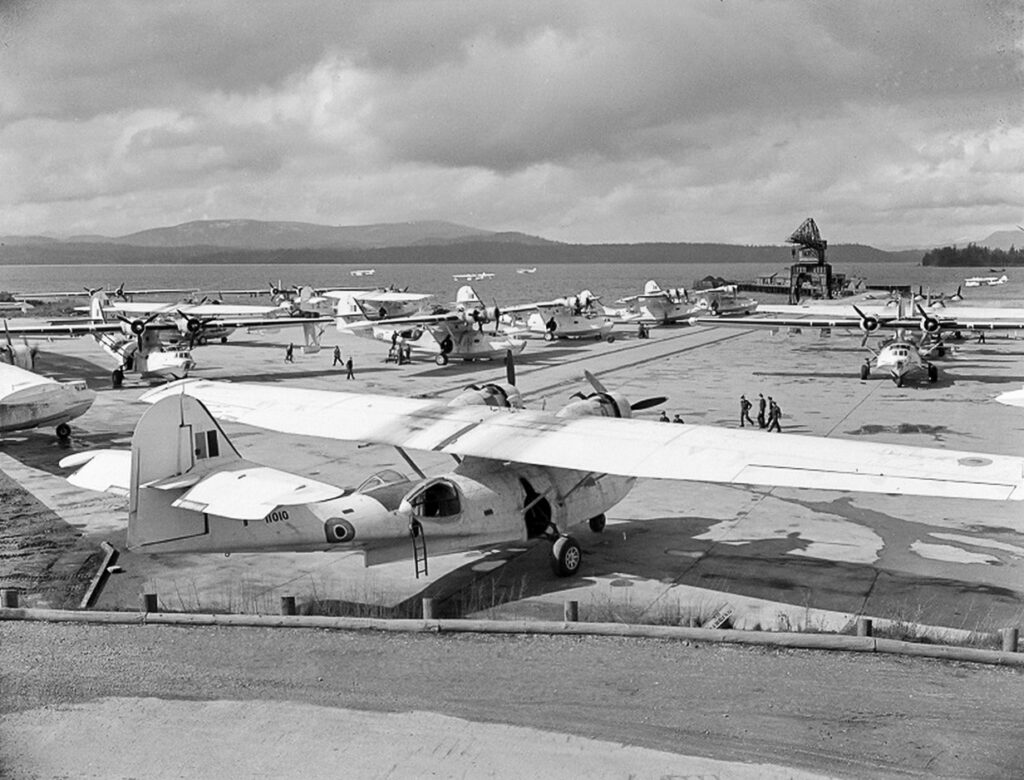
By mid-1944, the threat of a Japanese invasion of Western Canada had receded, so the RCAF decided to disband the Belle Bella Catalina squadron and close the station. 11005, along with its sisterships, continued in their anti-submarine role from Alliford Bay in the Queen Charlotte Islands, also in British Columbia, until this base was also disbanded on July 25, 1945.
With the war over, 11005 was no longer required in its original capacity and it entered a period of storage until it was converted to a freighter in 1948. Subsequently, 11005 flew out of Rockcliffe, Ontario before being redeployed one last time to fly search-and-rescue missions from Sea Island, Vancouver. It was finally struck off military service on May 25, 1961, having entered storage at Vulcan, Alberta.
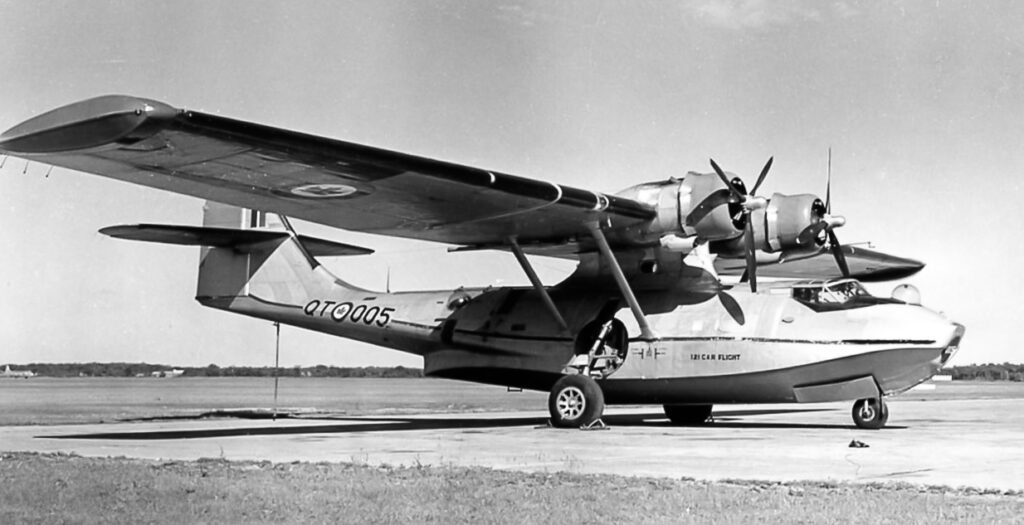
The aircraft was subsequently sold to the commercial sector, having had both its bow turret and side blisters removed as part of its post-war conversion. It was at this point that the plane began a new lease of life as a fire-fighting waterbomber. Having been re-registered as CF-NJF, it joined the fleet of Kentings, an established Canadian water bomber operator, and operated in this role for many years, fighting forest fires across Canada.

During the time, CF-NJF was also chartered to the French operator Protection Civile, based in Marseille, flying with them for several firefighting seasons during the mid-to-late 1960s. During these French deployments, the aircraft switched identities to become F-ZBAY and later on, F-ZBBD but always reverted to its Canadian marks on its return from France at the end of each summer season.
In 1974, it joined Norcanair, a firefighting company based at Prince Albert in Saskatchewan, and later had its registration amended from CF-NJF to C-FNJF in accordance with revised Canadian commercial aircraft practice. It also took up the moniker ‘Tanker 14’, as depicted on the side of the fuselage in large numbers.
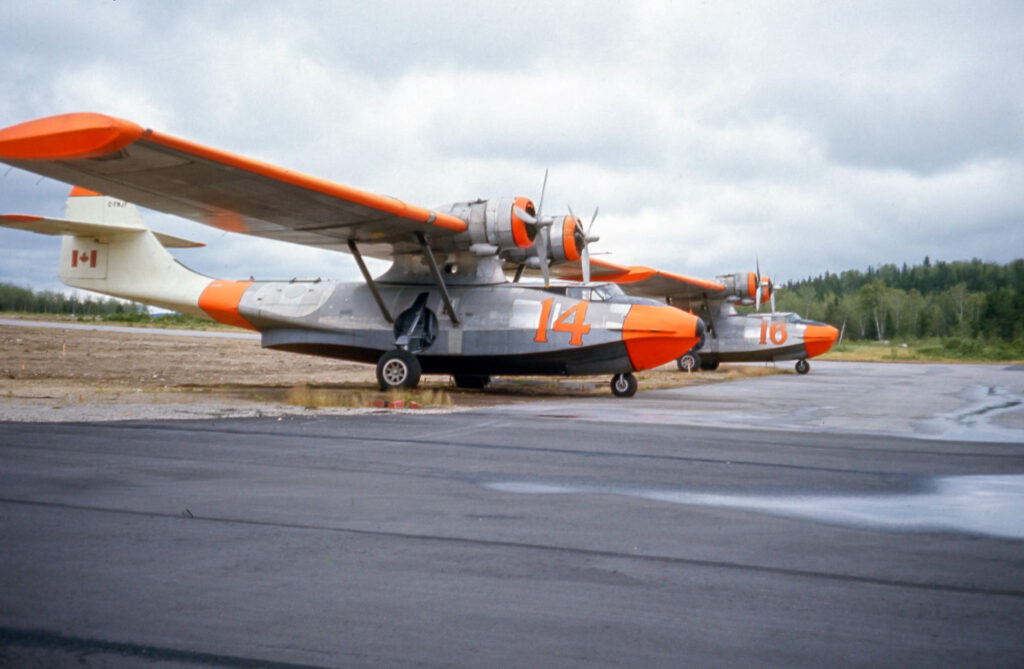
Around 1980, it was taken on by the Province of Saskatchewan which continued to use it as a water bomber, alongside other Catalinas as well as Canadair CL-215s. By the late-1990s, though, the Saskatchewan Catalinas had been disposed of, and two of them (including C-FNJF) were sent to storage in St Thomas, Ontario, their ultimate fate uncertain.
C-FNJF escaped being scrapped and was partially reprieved when it was taken on by another commercial operator, Catalina Aero Services, based in Nanaimo on Vancouver Island. There, it was to be repurposed as a passenger-carrying aircraft for tourist flights and air safaris in Zimbabwe in southern Africa. For this purpose, the aircraft had its water tanks removed and a hydraulic under-tail integrated airstair installed, along with a 14-seat passenger interior and spectacular rear one-piece Perspex blisters for unrivaled panoramic views of the passing landscape.
Sadly, this venture never actually got off the ground, and C-FNJF was once more put up for sale, spending some time being stored in the open where it was left to the mercy of the elements. When advertised for sale, the particulars for C-FNJF stated that the airframe had by this point flown for 12,829 hours.
In time, the aircraft was purchased by Plane Sailing Air Displays Limited, a UK-based organization whose mission was to keep the wartime legacy of Catalina flying boats alive by flying a single example at air shows and other events, both within Europe and further afield. With its sound airframe, plus the added benefits of a fully installed passenger cabin viewing blisters and airstair, C-FNJF was the ideal candidate.
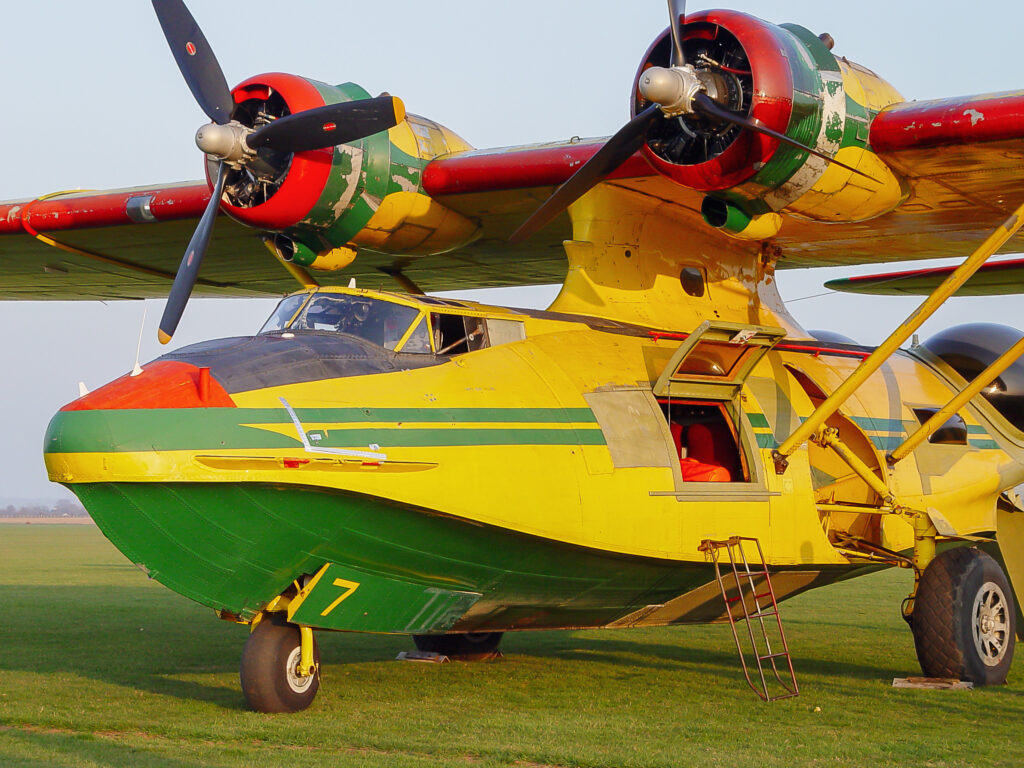
Once the decision to acquire C-FNJF was made, there followed a long period of work on the aircraft to make it ready not only for the long ferry flight to the UK but also for ongoing operations. This process became protracted, as various modifications made to the airframe required clearance by the Canadian regulator Transport Canada.
Eventually, however, all was ready and, following a period of test and familiarization flights, C-FNJF left Nanaimo on March 1, 2004. During the following month, the delivery route took in several US states before entering Canada again and then crossing the Atlantic. C-FNJF reached Shannon, Ireland in the early hours of March 30, 2004, before flying the last leg a few hours later to be met by a small band of dedicated crew, supporters, and representatives from the aviation press, radio and television reporters.
Following its triumphant arrival at Duxford, C-FNJF flew at several air shows during that same year. At the end of the 2004 season, C-FNJF entered a period of overhaul and preparation for the British registry as G-PBYA, being re-registered as such on November 19, 2004. The plane also was repainted from its bright yellow, red, and green colors into those of the US Army Air Force (USAAF-see below), which it still retains to this day.
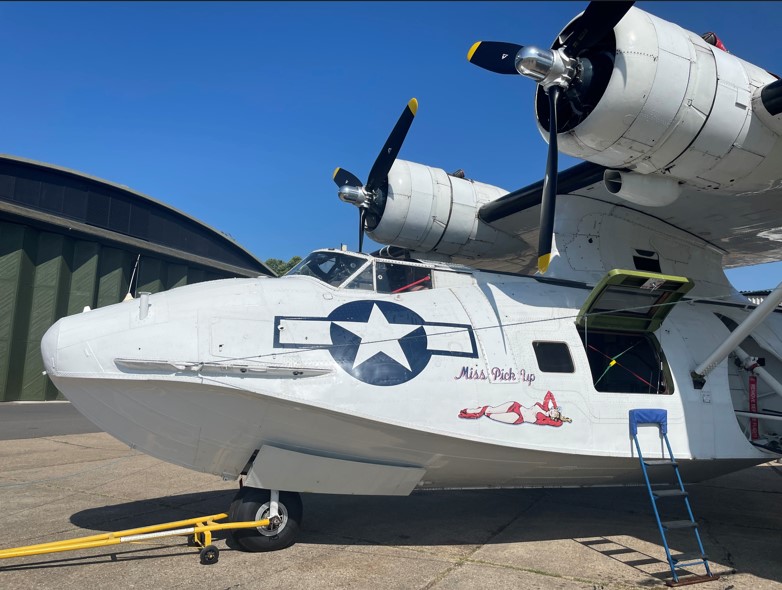
The Catalina is operated by Plane Sailing Air Displays Limited on behalf of Catalina Aircraft Limited, which is made up of a group of private shareholders and is even supported by The Catalina Society. The aircraft is based at Duxford Airfield near Cambridge in the UK, itself a legendary wartime airfield that hosted squadrons of Spitfires among other types, and is now home to one of Europe’s leading civil and military aircraft museums.
Throughout the 2024 air show season, G-PBYA will be appearing at over 20 shows across the UK and Europe, including events in France, Germany, Ireland, and even further afield.
About the original ‘Miss Pick Up’
It’s often asked why a Canadian-built Catalina, flying on the UK register for a private UK company, features US military markings. The reasons behind this are two-fold. The first is a commercially based decision, while the second is a nod to the legacy of the worldwide fleet of Catalinas and their crews during World War II, and one of those aircraft in particular.
Firstly, most air show organizers prefer ex-military aircraft, or ‘warbirds’, to be painted in a military scheme to gain bookings, so Plane Sailing needed a distinctive livery for G-PBYA when it came to be repainted from its yellow and green water bomber colors at the end of the 2004 display season.
The color scheme eventually chosen could not have been more apt. It was that of a particular USAAF Catalina, serial number 44-33915, that was based at RAF Halesworth, located around 70 miles from G-PBYA’s home base at Duxford Airfield. This plane carried the name given to by the crew originally tasked to fly it – ‘Miss Pick Up’ – plus featured corresponding wartime-era nose art.

In January 1945, aircraft 44-33915 was deployed, along with five sisterships, with the USAAF 5th Emergency Rescue Squadron of Catalinas based at RAF Halesworth. Their primary task was to perform air-sea rescue missions to recover USAAF pilots who had either been shot down or forced to ditch their aircraft in the North Sea, off the east coast of England. The Catalinas would be deployed to rescue these pilots and return them safely to Halesworth, which was also a significant USAAF base for P-47s and B-17 ‘Flying Fortresses’.
As it had been tasked with the job of picking up downed airmen from the sea, 44-33915 was named ‘Miss Pick Up’ by its crew.
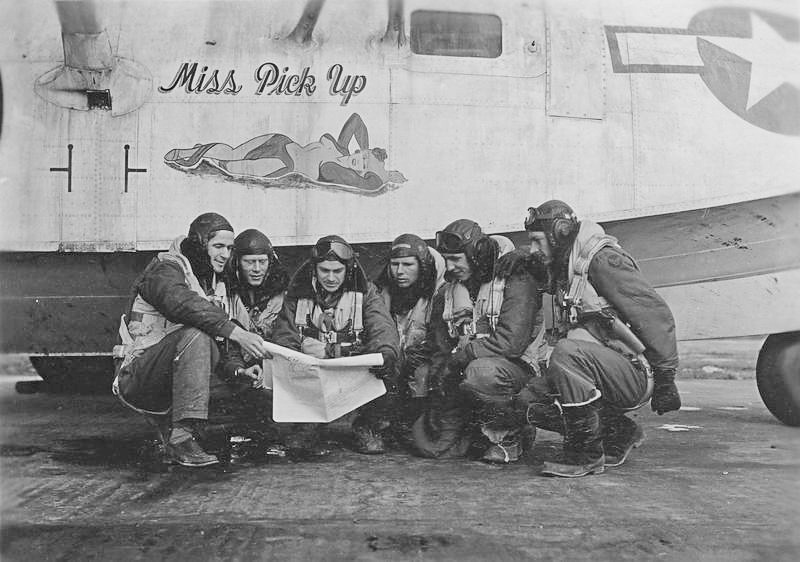
One wartime mission, in particular, made the service of the original Miss Pick Up a part of aviation folklore. It also represents the epitome of remarkable wartime heroism and resilience.
On March 30, 1945, 44-33915 was deployed, along with two other Catalinas, to rescue a downed USAAF P-51 Mustang pilot in the North Sea. However, due to rough conditions, the aircraft could not land on the water to pick up the pilot, who had taken to his life raft in a location three to five miles (5-8km) off the Dutch Island of Schiermonnikoog. Having located the pilot through his launching of emergency flares, 44-33915 landed on the water’s surface to recover him.
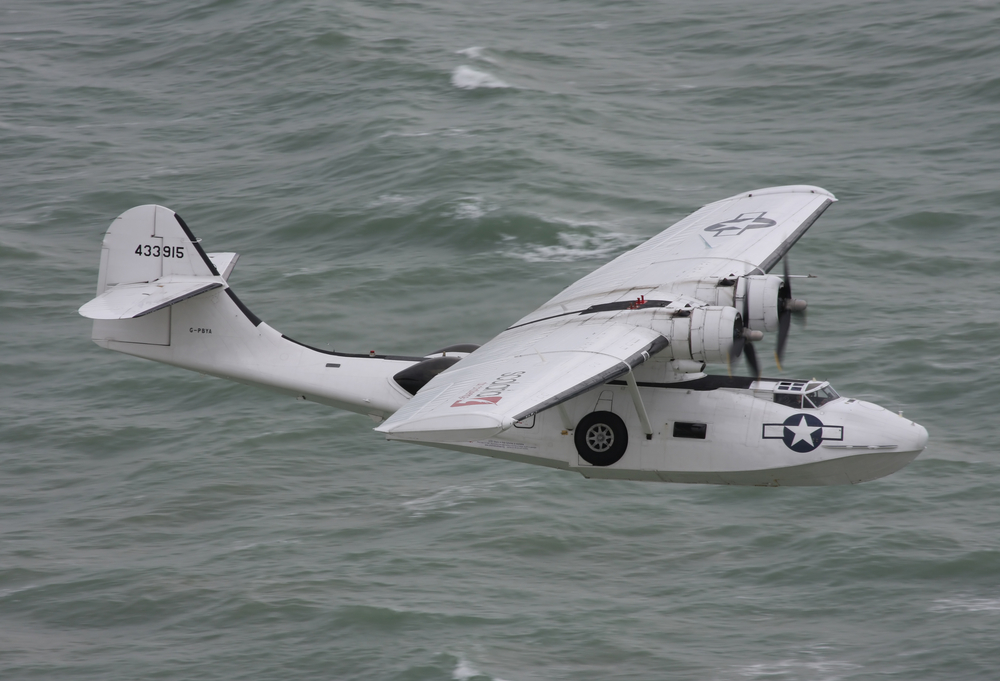
However, the aircraft suffered a broken main oil line upon landing and was unable to restart its starboard engine, though its hull remained sound. The plane taxied for 90 minutes on its one remaining engine, to move further away from the shoreline to remain safe.
The following morning, with Miss Pick Up effectively a ‘sitting duck’, a pair of German Meschersmitt ME262s spotted the aircraft and strafed it with machine gun fire. The tail was completely blown off, the port float was virtually shot away, and the port wing was damaged. Numerous holes had been made in the plane’s hull, so it started to take on water and sink. The crew of Miss Pick Up had little option but to abandon their beloved plane and take to lifeboats. The aircraft eventually sank (where it remains to this day).
The crew stayed in the lifeboats overnight, as a further rescue attempt was once again hampered by nightfall and poor weather. They then had to make it through the whole of the following day, April 1, 1945, without further rescue attempts being possible. On the next day, the crew endured more rough seas, with one of the life rafts being tossed over by the swell, although all airmen were recovered back to safety. Again, the conditions did not allow for any rescue attempts that day and by then the life raft engines had failed.
On the following day (April 3, 1945), the crew was spotted from overhead by USAAF planes that dropped more life rafts, supplies, and emergency flare equipment. Sea conditions were starting to settle, but it would not be until the next day that a full rescue attempt for Miss Pick Up’s crew would be made.
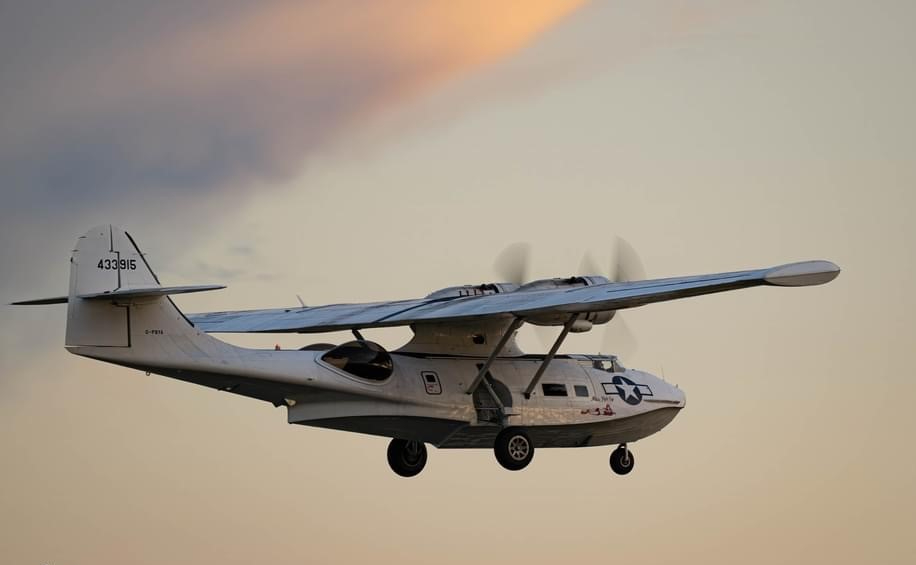
On the morning of April 4, 1945, the crew, by this point extremely wet, cold, and hungry, were themselves picked up by a motor rescue launch. They arrived in the coastal town of Great Yarmouth on April 5, 1945, before being transferred back to RAF Halesworth. Sadly, the P-51 Mustang pilot that they had set out to recover some seven days previously had washed ashore in Holland and been taken as a Prisoner of War by the Germans.
Given the bravery shown by the crew of 44-33915 over those seven arduous days in 1945, it was decided that G-PBYA would assume the colors of the original Miss Pick Up – partly as a mark of respect for a locally based Catalina and its crew, but to be an active flying memorial to all the wartime Catalinas and crews who served so tirelessly in the face of grave danger during World War Two.
Conclusion
At the end of the 2024 air show season, G-PBYA ‘Miss Pick Up’ will return to winter hibernation in one of the hangars at Duxford Airfield. Once there, she will undergo her annual program of heavy maintenance, much of it carried out by a team of loyal volunteers under the watchful eye of the aircraft’s chief engineer, before she reappears in April 2025 to perform for air show crowds once again.
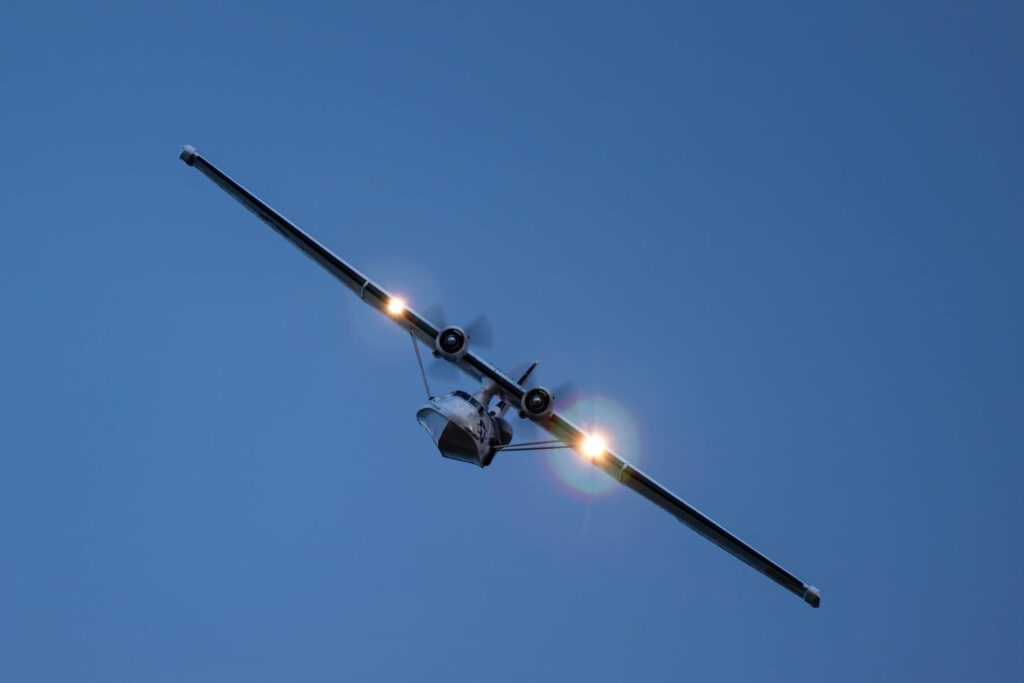
Earning respect and bringing smiles to all those who see her fly, Miss Pick Up, despite her vintage, will hopefully continue to perform her tasks with grace and style for many years to come, bringing wonder to air show crowds while also keeping the wartime legacy of Catalinas alive for future generations.
AeroTime would like to thank David Legg of The Catalina Society for his assistance with the historical details featured in this article. For all inquiries relating to the purchase of shares in Catalina G-PBYA, David can be contacted via email at pby5@btinternet.com.

